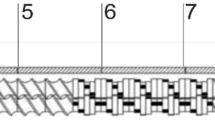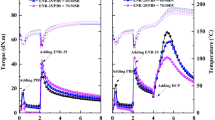Abstract
Ternary polymer blends of poly (lactic acid), poly(butylene adipate-co-terephthalate), and modified natural rubber (ENR) (PLA/PBAT/ENR) were prepared in a ratio of 80/10/10 (denoted as P811) via reactive extrusion process. HDPE was then blended with P811 at various ratios of 80/20, 90/10 and 95/5 percent by weight. The mechanical, chemical, morphological, and water contact angle properties were investigated in this study. The mechanical properties of HDPE/P811 blends tend to decrease with increasing P811 content up to 20 wt% due to incompatibility between HDPE and P881. However, HDPE/P811 shows good performance in tensile strength but other performance declines, such as an elongation at break and Young’s modulus including impact strength. Therefore, this study finds that the optimum ratio of HDPE/P811 blending is 90/10. The water contact angle measurement reveals the wetting property of the blends compared to neat polymer. The thermal properties of HDPE/P811 indicate that the melting temperature (Tm) shifts to a higher degree compared to neat HDPE, while the crystallinity percent of polymer blends tend to decrease with higher P881 content. Scanning electron microscope (SEM) images and infrared spectrum show well-dispersed particles and incompatibility in the chemical interactions between HDPE and P811, respectively.









Similar content being viewed by others
References
Eriksen M, Lebreton LCM, Carson HS, Thiel M, Moore CJ et al (2014) Plastic pollution in the World’s oceans: more than 5 trillion plastic pieces weighing over 250,000 tons afloat at sea. PLoS ONE 9(12):e111913. https://doi.org/10.1371/journal.pone.0111913
Zhu J, Wang C (2020) Biodegradable plastics: Green hope or greenwashing? Marine Pollut Bull 161:111774. https://doi.org/10.1016/j.marpolbul.2020.111774
Soroudi A, Jakubowicz I (2013) Recycling of bioplastics, their blends and biocomposites: a review. Eur Polym J 49(10):2839–2858. https://doi.org/10.1016/j.eurpolymj.2013.07.025
Wang Y-L, Xiao Hu, Hai Li, XuZhong-Ming JiLi (2010) Polyamide-6/Poly(lactic acid) blends compatibilized by the maleic anhydride grafted polyethylene-octene elastomer. Polym-Plast Technol Eng 49(12):1241–1246. https://doi.org/10.1080/03602559.2010.496418
Lewitus D, McCarthy S, Ophir A et al (2006) The effect of nanoclays on the properties of PLLA-modified polymers Part 1: mechanical and thermal properties. J Polym Environ 14:171–177. https://doi.org/10.1007/s10924-006-0007-6
Willett JL (1994) Mechanical properties of LDPE/granular starch composites. J Appl Polym Sci 54:1685–1695. https://doi.org/10.1002/app.1994.070541112
Abbott AP, Abolibda TZ, Wanwan Q, Wise WR, Luka A (2017) Wright Thermoplastic starch–polyethylene blends homogenised using deep eutectic solvents. RSC Adv. 7:7268
Beg MDH, Kormin S, Bijarimi M, Zaman HU (2016) Preparation and characterization of low-density polyethylene/thermoplastic starch composite. Adv Polym Technol. https://doi.org/10.1002/adv.21521
Sapkota J, Natterodt JC, Shirole A, Foster EJ, Weder C (2017) Fabrication and properties of polyethylene/cellulose nanocrystal composites. Macromol. Mater. Eng. 302(1):1600300. https://doi.org/10.1002/mame.201600300
Yasim-Anuar TAT, Ariffin H, Norrrahim MNF, Hassan MA, Andou Y, Tsukegi T, Nishida H (2020) Well-dispersed cellulose nanofiber in low density polyethylene nanocomposite by liquid-assisted extrusion. Polymers 12:927. https://doi.org/10.3390/polym12040927
Aht-Ong D, Atong D, Pechyen C (2011) Surface and mechanical properties of cellulose micro-fiber reinforced recycle polyethylene film. Mater Sci Forum 695:469–472. https://doi.org/10.4028/www.scientific.net/msf.695.469
Bengtsson M, Gatenholm P, Oksman K (2005) The effect of crosslinking on the properties of polyethylene/wood flour composites. Compos Sci Technol 65:1468–1479. https://doi.org/10.1016/j.compscitech.2004.12.050
Imre B, Pukánszky B (2013) Compatibilization in bio-based and biodegradable polymer blends. Eur Polym J 49:1215–1233. https://doi.org/10.1016/j.eurpolymj.2013.01.019
Rosa D, Guedes C, Carvalho C (2007) Processing and thermal, mechanical and morphological characterization of post-consumer polyolefins/thermoplastic starch blends. J Mater Sci 42:551–557. https://doi.org/10.1007/s10853-006-1049-9
Utracki LA, Shi GZH (2003) Compounding Polymer Blends. In: Utracki, LA. (eds) Polymer Blends Handbook. Dordrecht: Springer https://doi.org/10.1007/0-306-48244-4_9
Wang B, Jin Y, Yang N, Weng Y, Huang Z, Men S (2020) Investigation on compatibility of PLA/PBAT blends modified by epoxy-terminated branched polymers through chemical micro-crosslinking. e-Polymers 20(39):54
Kaseem M, Rehman ZUr, Hossain S, Singh AK, Dikici B (2021) A review on synthesis, properties, and applications of polylactic Acid/Silica composites. Polymers 13:3036. https://doi.org/10.3390/polym13183036
Shameli K, Ahmad MB, Zin WMd, Yunus W, Ibrahim NA, Rahman RA, Darroudi MJM (2010) Silver/poly (lactic acid) nanocomposites: preparation, characterization, and antibacterial activity. Int J Nanomed 5:573–579. https://doi.org/10.2147/IJN.S12007
Tenn N, Follain N, Soulestin J, Crétois R, Bourbigot S, Stéphane (2013) Marais effect of nanoclay hydration on barrier properties of PLA/montmorillonite based nanocomposites. J Phys Chem C 117(23):12117–12135. https://doi.org/10.1021/jp401546t
Yang Y, Zhang M, Zixin J, Tam PY, Hua T, Younas MW, Kamrul H, Hong H (2020) Poly(lactic acid) fibers, yarns and fabrics: manufacturing, properties and applications. Textile Res J. https://doi.org/10.1177/0040517520984101
Sanivada UK, Mármol G, Brito FP, Fangueiro R (2020) PLA composites reinforced with flax and jute fibers—a review of recent trends. Process Paramet Mech Properties. Polym 12:2373. https://doi.org/10.3390/polym12102373
Li H, Liu B, Ge L, Chen Y, Zheng H, Fang D (2021) Mechanical performances of continuous carbon fiber reinforced PLA composites printed in vacuum. Compos Part B: Eng. https://doi.org/10.1016/j.compositesb.2021.109277
Hamada K, Kaseem M, Deri F, Ko YG (2016) Mechanical properties and compatibility of polylactic acid/polystyrene polymer blend. Mater Lett 164:409–412
Ma X, Yu J, Wang N (2006) Compatibility characterization of poly(lactic acid)/poly(propylene carbonate) blends. J Polym Sci B Polym Phys 44:94–101. https://doi.org/10.1002/polb.20669
Jun CL (2000) Reactive blending of biodegradable polymers: PLA and starch. J Polym Environ 8:33–37. https://doi.org/10.1023/A:1010172112118
Mo XZ, Wei FX, Tan DF et al (2020) The compatibilization of PLA-g-TPU graft copolymer on polylactide/thermoplastic polyurethane blends. J Polym Res 27:33. https://doi.org/10.1007/s10965-019-1999-7
Su S, Kopitzky R, Tolga S, Kabasci S (2019) Polylactide (PLA) and its blends with poly(butylene succinate) (PBS): a brief review. Polymers (Basel). 11(7):1193. https://doi.org/10.3390/polym11071193
Yang H-R, Jia G, Hao W, Ye C, Yuan K, Liu S, Zhou L, Huan X, Gao L, Cui J, Fang S (2022) Design of fully biodegradable super-toughened PLA/PBAT blends with asymmetric composition via reactive compatibilization and controlling morphology. Mater Lett. https://doi.org/10.1016/j.matlet.2022.133067
Hajba S, Tábi T (2017) Poly(Lactic Acid)/natural rubber blends. Mater Sci Forum 885:298–302. https://doi.org/10.4028/www.scientific.net/MSF.885.298
Sathornluck S, Choochottiros C (2019) Modification of epoxidized natural rubber as a PLA toughening agent. J Appl Polym Sci 136:48267. https://doi.org/10.1002/app.48267
Alias NF, Ismail H (2019) An overview of toughening polylactic acid by an elastomer. Polym-Plastics Technol Mater 58(13):1399–1422
Gu SY, Zhang K, Ren J, Zhan H (2008) Melt rheology of polylactide/poly(butylene adipate-co-terephthalate) blends. Carbohydr Polym 74:79–85. https://doi.org/10.1016/j.carbpol.2008.01.017
Teamsinsungvon A, Ruksakulpiwat Y, Jarukumjorn K (2013) Preparation and characterization of poly(lactic acid)/poly(butylene adipate-co-terepthalate) blends and their composite. Polym. Plast. Technol. Eng. 52:1362–1367. https://doi.org/10.1080/03602559.2013.820746
Supawan S, Chantiga C (2019) Modification of epoxidized natural rubber as a PLA toughening agent. J of Appl polym Sci 136:48267. https://doi.org/10.1002/app.48267
Pivsa-Art S, Kord-Sa-Ard J, Pivsa-Art W, Wongpajan R, Narongchai O, Pavasupree S, Hamada H (2016) Effect of compatibilizer on PLA/PP blend for injection molding. Energy Procedia 89:353–360
Ploypetchara N, Suppakul P, Atong D, Pechyen C (2014) Blend of polypropylene/Poly(lactic acid) for medical packaging application: physicochemical. Therm, Mech Barrier Properties, Energy Procedia 56:201–210
Sam ST, Hani N, Ismail H, Noriman N, Ragunathan S (2014) Investigation of epoxidized natural rubber (ENR 50) as a compatibilizer on cogon grass filled low density polyethylene/soya spent flour. MSF 803:310–316. https://doi.org/10.4028/www.scientific.net/msf.803.310
Zormy NCP, Jaime DBS, Pedro OG, Marcos ASG, José JBJ, Alfonso BC, Silvia BB, Liliana BHC (2020) Preparation and characterization of bio-based PLA/PBAT and cinnamon essential oil polymer fibers and life-cycle assessment from hydrolytic degradation. Polymers 12:38. https://doi.org/10.3390/polym12010038
Zhuang YX, Hansen O (2009) Correlation of effective dispersive and polar surface energies in heterogeneous self-assembled monolayer coatings. Langmuir 25:5437–5441. https://doi.org/10.1021/la804318p
Wang Y, Shi J, Han L, Xiang F (2009) Crystallization and mechanical properties of TZnOw/HDPE composites. Mater Sci Eng A 501:220–228. https://doi.org/10.1016/j.msea.2008.09.061
Pongtanayut K, Thongpin C, Santawitee O (2013) The effect of rubber on morphology, thermal properties and mechanical properties of PLA/NR and PLA/ENR blends. Energy Procedia 34:888–897. https://doi.org/10.1016/j.egypro.2013.06.826
Mat UW, Azman H, Akos NI, Nurhayati AZ, Kayathre K (2015) Mechanical, thermal and chemical resistance of epoxidized natural rubber toughened polylactic acid blends. Sains Malays.44:11:1615–1623. https://www.ukm.my/jsm/pdf_files/SM-PDF-44-11-2015/11%20Mat%20Uzir.pdf
Poh BT, Lee KS (1994) FTIR study of thermal oxidation of ENR. Polym J 1:17–23
Jenjira K, Varaporn T (2020) The effect of epoxide content on compatibility of poly(lactic acid)/epoxidized natural rubber blends. J Appl Polym Sci 137:48996. https://doi.org/10.1002/app.48996
Ekwipoo K, Donlaporn K, Ponusa S, Thummanoon P, Jobish J, Yeampon N, Ladawan S (2020) Influence of modified natural rubbers as compatibilizers on the properties of flexible food contact materials based on NR/PBAT blends. Mater and Des 196:109134. https://doi.org/10.1016/j.matdes.2020.109134
Skulrat P, Suwaluk W, Chattrapa T, Charoen N (2016) Novel ternary blends of natural rubber/linear low-density polyethylene/thermoplastic starch: influence of epoxide level of epoxidized natural rubber on blend properties. Iran Polym J 25:711–723. https://doi.org/10.1007/s13726-016-0459-z
Ismail H, Ooi ZX (2010) The effect of epoxidized natural rubber (ENR-50) as a compatibilizer on properties of high-density polyethylene/soya powder blends. Polym Plast Technol Eng 49:688–693. https://doi.org/10.1080/03602551003682059
Johannes KF (2018) Chapter 18 Grafting. Reactive polymers fundamentals and applications - a concise guide to industrial polymers, 3rd edn. Elsevier, Boston, pp 563–600
Moustafa H, Guizani C, Dupont C, Martin V, Jeguirim M, Dufresne A (2017) Utilization of torrefied coffee grounds as reinforcing agent to produce high-quality biodegradable PBAT composites for food packaging applications. ACS Sustain Chem Eng 5:1906–1916. https://doi.org/10.1021/acssuschemeng.6b02633
Siddharth SY, Basant SS, Priya R, Rajiv J, Ayush G (2020) Surface tension measurement of normal human blood samples by pendant drop method. J Med Eng 44:227–236. https://doi.org/10.1080/03091902.2020.1770348
Natacha B, Raquel V, Philippe C, Lopez-Manchado MA (2011) Structure and properties of polylactide/natural rubber blends. Mater Chem Phys 129:823–831. https://doi.org/10.1016/j.matchemphys.2011.05.016
Suksut B, Deeprasertkul C (2011) Effect of nucleating agents on physical properties of poly(lactic acid) and its blend with natural rubber. J Polym Environ 19:288–296. https://doi.org/10.1007/s10924-010-0278-9
Eduardo HB, Laís NP, Lidiane CC, Fabio RP, Luiz AP (2019) Analysis of the degradation during melt processing of PLA/Biosilicate® Composites. J Compos Sci 3:52. https://doi.org/10.3390/jcs3020052
Shen S, Mona D, Rodion K (2020) Uncompatibilized PBAT/PLA blends: manufacturability, miscibility and properties. Materials 13:4897. https://doi.org/10.3390/ma13214897
Anna M, Marian Z (2014) ENR/PCL polymer biocomposites from renewable resources. Chimie 17:944–951. https://doi.org/10.1016/j.crci.2013.10.008
Mohd B, Sahrim A, Rozaidi R (2014) Mechanical, thermal and morphological properties of poly(lactic acid)/epoxidized natural rubber blends. J Elastomers Plast 46:338–354
Benjamin M, Sebastien P, Luanda CL, Sebastien L, JFG, Jannick DR (2016) Probing nanomechanical properties with AFM to understand the structure and behavior of polymer blends compatibilized with ionic liquids. RSC Adv 6:96421–96430. https://doi.org/10.1039/C6RA18492H
Chunmei Z, Weiwei W, Yun H, Yonghao P, Long J, Yi D, Yongyue L, Zheng P (2013) Thermal, mechanical and rheological properties of polylactide toughened by expoxidized natural rubber. Mater and Des 45:198–205. https://doi.org/10.1016/j.matdes.2012.09.024
Di Maio L, Garofalo E, Scarfato P, Incarnato L (2015) Effect of polymer/organoclay composition on morphology and rheological properties of polylactide nanocomposites. Polym Compos 36:1135. https://doi.org/10.1002/pc.23424
Jeannine B, Renan BP, Rodrigo VL, Ana MQBB, Paulo JAS (2020) Biodegradability in aquatic system of thin materials based on chitosan, PBAT and HDPE polymers: respirometric and physical-chemical analysis. Int J Biol Macromol 164:1399–1412. https://doi.org/10.1016/j.ijbiomac.2020.07.309
Rosniza H, Mohamad AB, Omar SD, Nik NZ, Saad SD (2016) A structural study of epoxidized natural rubber (ENR-50) ring opening under mild acidic condition. J Appl Polym Sci 133:44123. https://doi.org/10.1002/app.44123
Michael RS, Amar KM, Manjusri M (2018) Effect of compatibilization on biobased rubber-toughened poly(trimethylene terephthalate): miscibility, morphology, and mechanical properties. ACS Omega 3:7300–7309. https://doi.org/10.1021/acsomega.8b00490
Mahsa N, Azam JA, Hamid M (2019) High-performance bio-based poly(lactic acid)/natural rubber/epoxidized natural rubber blends: effect of epoxidized natural rubber on microstructure, toughness and static and dynamic mechanical properties. Polym Int 3:439–446. https://doi.org/10.1002/pi.5727
Parthasarathi V, Sundaresan B, Dhanalakshmi V, Anbarasan R (2010) Functionalization of HDPE with aminoester and hydroxyester by thermolysis method—An FTIR-RI approach. Thermochim Acta 510:61–67. https://doi.org/10.1016/j.tca.2010.06.023
Kunyu Z, Manjusri M, Amar KM (2014) Toughened sustainable green composites from poly(3-hydroxybutyrate-co-3-hydroxyvalerate) based ternary blends and miscanthus biofiber. ACS Sustain Chem Eng 2:2345–2354. https://doi.org/10.1021/sc500353v
Author information
Authors and Affiliations
Corresponding author
Additional information
Publisher's Note
Springer Nature remains neutral with regard to jurisdictional claims in published maps and institutional affiliations.
Rights and permissions
Springer Nature or its licensor (e.g. a society or other partner) holds exclusive rights to this article under a publishing agreement with the author(s) or other rightsholder(s); author self-archiving of the accepted manuscript version of this article is solely governed by the terms of such publishing agreement and applicable law.
About this article
Cite this article
Wiphanurat, C., Hanthanon, P., Ouipanich, S. et al. Blending HDPE with biodegradable polymers using modified natural rubber as a compatibilizing agent: mechanical, physical, chemical, thermal and morphological properties. Polym. Bull. 80, 11421–11437 (2023). https://doi.org/10.1007/s00289-022-04595-3
Received:
Revised:
Accepted:
Published:
Issue Date:
DOI: https://doi.org/10.1007/s00289-022-04595-3




